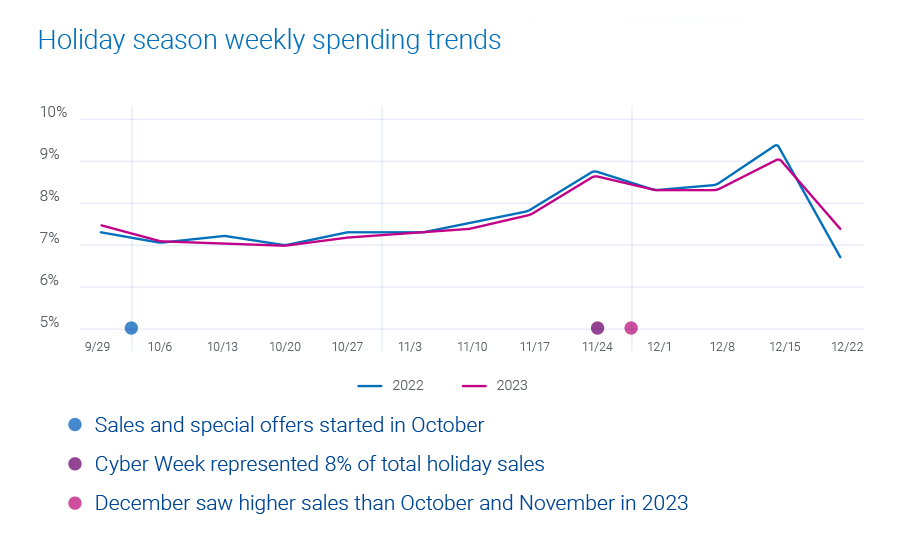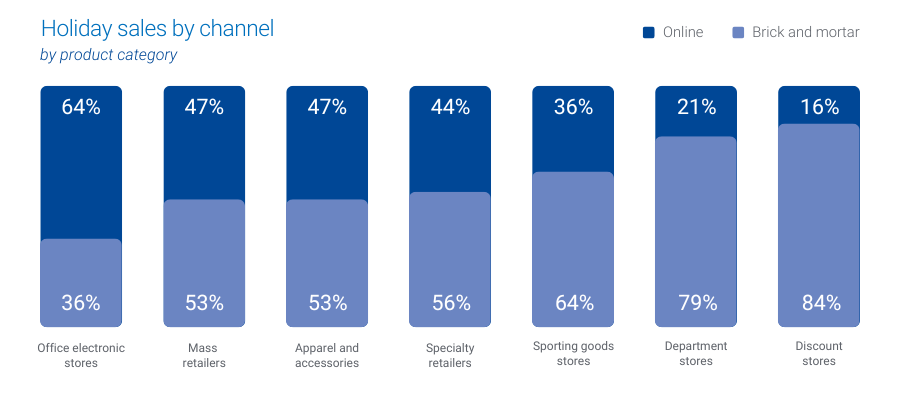
This holiday shopping season, marketers will look to take advantage of the surge in spending across channels like connected TV (CTV), programmatic, and mobile. Despite challenges such as privacy regulations and Google’s new cookie deprecation plan, this moment presents a unique opportunity for marketers to reshape their traditional approaches to consumer engagement and capitalize on these changes.
As we approach the holiday season, understanding how consumers spend, where they shop, and how their shopping habits are changing are key components to consider when crafting your holiday advertising campaigns. Our 2024 Holiday spending trends and insights report utilizes our expertise in data and insights to highlight emerging consumer behaviors and spending patterns. In our report, we share what these trends mean for marketers and how Experian can help, so you can refine your messaging and target the right audience through the best channels.
In this blog post, we cover three insights from our report. Watch our video for a recap below.
1. Consumers are shopping evenly throughout the holiday season
35% of holiday shopping was done in December, peaking at 9% of total holiday sales the week before Christmas. Cyber Week, the five-day period between Thanksgiving and Cyber Monday, and the week before Christmas brought the highest weekly sales for the past two holiday seasons.

What this means for marketers
Prepare for an extended promotional period. Schedule your marketing campaigns and sales initiatives to maximize impact during the extended season, focusing on the peaks of Cyber Week and the week before Christmas.
How Experian can help you target these shoppers
Experian’s data, ranked #1 in accuracy by Truthset, offers advertisers the ability to reach people based on demographic, geographic, and behavioral attributes (e.g. websites visited and purchase history). Our audiences are available on-the-shelf of most major platforms, making it easy for you to activate and target holiday shoppers.
We recently released 19 new holiday-focused audience segments. Here are a few you can activate:
- Black Friday Shoppers
- Cyber Monday Shoppers
- Big Box/Club Store Shoppers
- Luxury Gift Shoppers
- Discount Holiday Shoppers
- Holiday Airline Travel
2. Online shopping is leveling out
Online holiday spending continues to remain around a third of all holiday shopping spending.
We are starting to see online shopping slow and level out – people are going back in-store. The high amount of online shopping we saw during the pandemic is starting to return to pre-pandemic behaviors.

Consumers are spending more in-store at department and discount stores but are shopping online for office/electronics/games, mass retailers, and apparel.

- 84% of holiday shopping was done in-store for discount stores.
- 79% of holiday shopping was done in-store for department stores.
- 64% of holiday shopping was done online for office, electronics, and games stores.
What this means for marketers
Digital and physical experiences work together. Retailers should have a multi-channel plan to reach consumers, tailoring their approach to their target audience and product and creating engaging in-store experiences to drive visitors.
How Experian can help you target and measure across channels
We connect online and offline data to enable precise targeting and measurement of marketing efforts across multiple channels. Read our case study with Cuebiq to learn how they used our Activity Feed solution to deliver in-store lift analyses to their clients.
3. CTV is the top channel to reach consumers
Over two-thirds of the U.S. population now use CTV, and the average time spent among adults is expected to surpass two hours per day in 2024. CTV offers a creative ad experience similar to its linear counterpart but provides more sophisticated targeting and analytics capabilities.
What this means for marketers
As CTV viewing continues to dominate, the importance of cross-device targeting and measurement increases.
How Experian can help you reach shoppers across devices
Later this year, we’ll add support for IPv6 in our Digital Graph as well as phone-based UID2s. This is in addition to our current coverage of IPv4 and email-based UID2s. As a result, all IP signals and UID2s will be resolved back to Experian’s household and individual profiles and their associated devices, which means marketers and platforms can better understand the full customer journey and reach people across their devices.
Download our 2024 Holiday spending trends and insights report
This holiday season is about more than just transactions – it’s about cultivating meaningful connections with your audience. Download our 2024 Holiday spending trends and insights report to access all of our predictions for this year’s holiday season.
When you work with Experian for your holiday shopping campaigns, you’re getting:
- Accurate consumer insights: Better understand your customers’ behavioral and demographic attributes with our #1 ranked data covering the full U.S. population.
- Signal-agnostic identity solutions: Our deep understanding of people in the offline and digital worlds provides you a persistent linkage of personally identifiable information (PII) data and digital IDs, ensuring you accurate cross-device targeting, addressability and measurement.
- Secure connectivity: Bring data and identity to life in a way that meets your needs by securely sharing data between partners, utilizing the integrations we have across the ecosystem, and using our marketing data in flexible ways.
Make the most of this holiday shopping season with Experian. Contact us today to get started.
Latest posts

With all the debate and speculation regarding Groupon and its planned IPO, I thought it would be a great time to check back in with our previous analysis of traffic to Groupon and its nearest competitor Living Social. First, to be clear, the above chart measures web-based traffic to both domains and does not include mobile or app specific traffic. Regardless of these exclusions, the drop-off in Groupon traffic this summer has been significant nearly 50% since its peak in the second week of June 2011 compared to last week. During the same time, Living Social has achieved 27% growth in visits to its site. Overall visits to a custom category of Daily Deal & Aggregator sites were down 25% for the same time. So why is there a narrowing of the gap between the two market leaders in group coupons? Perhaps it is simply a case of increased number of competitors and deal fatigue among consumers or simply not enough of the right deals. PriceGrabber® released results from its Local Deals Survey in June, stating that 44% of respondents said they use or search daily deal Websites. However, 52% expressed feeling overwhelmed by the number of bargain-boasting emails they receive on a daily basis. While consumer fatigue may be one factor another key consideration for these sites is to focus on the attracting new and preferred audience segments via the inbox. Currently the audience segments for both Groupon and Living Social are very similar so it will be interesting to see how both sites and category perform heading into the holiday season.

Newton was only half right: Objects in motion tend to stay in motion, but objects at rest are increasingly becoming mobile. That’s the case, at least, when it comes to the world of today’s mobile consumer. According to exclusive research from Experian Simmons, fully 29% of cell phone owners today believe that their cell phone will be the primary device for their entertainment needs, in the future. Furthermore, a recent report by J.P. Morgan estimates that U.S. mobile ad spending will nearly double in 2011 to $1.2 billion. Screen size and limitations on creative, the report says, present obstacles to mobile advertisers. These obstacles and opportunities make it more important than ever for marketers to understand the behaviors and mindset of the mobile consumer. In this first in a series of blog posts, we will explore some key findings presented in the 2011 Mobile Consumer Report recently published recently by Experian Simmons. Media outlets have started to take note, citing the report in articles here and here. Come back to this blog frequently for further updates, or download the full report today. Mobile Market Overview Cell phone ownership among American adults stands at 91%, up from 72% in 2006. The vast majority of teens, too, have joined the mobile revolution, with 74% of those ages 12 to 17 porting a portable phone, up from 59% in 2006. Even tots are getting into the act, with a reported 22% of kids ages 6 to 11 owning a cell phone today. Among adults ages 22 to 24, the idea of not owning a cell is virtually unheard of, with an astounding 98% of consumers in this bracket reporting personally owning a cell phone. While cell ownership among adults age 65+ is the lowest of any adult segment, it is the fastest growing, having increased a relative 52% between 2006 and 2010. Despite the rise in youth owning cell phones, 90% of all mobile phone owners in the U.S. are adults, a rate unchanged since 2008. Percent of Americans that own a cell phone, by age Mobile Service Providers Verizon maintains its position as America’s number one cell phone service provider, with 32% of all adult mobile phone owners saying they are Verizon subscribers as of May 23, 2011. AT&T also has a sizable share of the market, with 28% of mobile phone owners subscribing to AT&T for cell service. Battling for third place are Sprint and T-Mobile, which respectively claim just 11% and 10% of the mobile market. Smaller, often regional, providers may individually have fewer subscribers, but combined, claim an impressive 22% of the total cellular market. Verizon and AT&T will almost certainly continue to dominate the market, especially given the fact that cell phone subscribers are increasingly staying with their provider for an extended period of time. As of May 23, 2011, the average cell phone subscriber had been with their provider for 3 years and 2 months, up from 2 years and 11 months observed at the beginning of 2008. Furthermore, 59% of cell phone subscribers say they’ve been with their current provider for at least 4 years, up from 46% who reported the same in early 2008. 59% of cell phone subscribers say they’ve been with their current provider for at least 4 years Service Providers’ Share of Cell Phone Subscribers Click here to learn more about obtaining vivid consumer research from Experian Simmons and don’t forget to check back here for new blog posts on mobile consumers.

The popularity of flash sale websites with limited time & inventory offerings have grown exponentially over the two years. Online shoppers’ love for the thrill of snagging designer clothing, home décor, travel and even wine have caused visits to the category to increase 368% in July 2011 as compared to the same month two years ago and 109% one year ago. So far in 2011, Nordstrom acquired HauteLook, Amazon entered the fray with MyHabit and recently Saks Fifth Avenue announced the launch of a dedicated flash sale website after offering sale events per week on Saks’ main website. In July 2011, Zulily.com, a website offering sales targeted for women and babies/kids, captured the highest market share of visits at 16%, followed by Ideeli and LivingSocial Escapes. Amazon’s MyHabit ranked 11th, out of the 87 websites in the custom category after only 2 months in operation. Several of the major players over the past six months, the total visits to Ideeli increased 42%, Gilt.com up 14% and Nordstrom’s Hautelook up 8% for July 2011 as compared to February 2011. Total visits for MyHabit jumped 128% for July 2011 as compared to May 2011 when the website launched. The audience for Flash Sales continues to be attractive, and willing to shop – over-indexing against the online population for household incomes over $100k and creditworthy VantageScores of A and B.